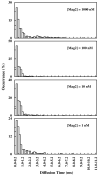Diffusion as a probe of peptide-induced membrane domain formation
- PMID: 21332237
- PMCID: PMC3062684
- DOI: 10.1021/bi102068j
Diffusion as a probe of peptide-induced membrane domain formation
Abstract
Recently, we have shown that association with an antimicrobial peptide (AMP) can drastically alter the diffusion behavior of the constituent lipids in model membranes (Biochemistry 49, 4672-4678). In particular, we found that the diffusion time of a tracer fluorescent lipid through a confocal volume measured via fluorescence correlation spectroscopy (FCS) is distributed over a wide range of time scales, indicating the formation of stable and/or transient membrane species that have different mobilities. A simple estimate, however, suggested that the slow diffusing species are too large to be attributed to AMP oligomers or pores that are tightly bound to a small number of lipids. Thus, we tentatively ascribed them to membrane domains and/or clusters that possess distinctively different diffusion properties. In order to further substantiate our previous conjecture, herein we study the diffusion behavior of the membrane-bound peptide molecules using the same AMPs and model membranes. Our results show, in contrast to our previous findings, that the diffusion times of the membrane-bound peptides exhibit a much narrower distribution that is more similar to that of the lipids in peptide-free membranes. Thus, taken together, these results indicate that while AMP molecules prompt domain formation in membranes, they are not tightly associated with the lipid domains thus formed. Instead, they are likely located at the boundary regions separating various domains and acting as mobile fences.
Figures






Similar articles
-
Diffusion as a probe of the heterogeneity of antimicrobial peptide-membrane interactions.Biochemistry. 2010 Jun 8;49(22):4672-8. doi: 10.1021/bi100426p. Biochemistry. 2010. PMID: 20455545 Free PMC article.
-
Does cholesterol suppress the antimicrobial peptide induced disruption of lipid raft containing membranes?Biochim Biophys Acta. 2012 Dec;1818(12):3019-24. doi: 10.1016/j.bbamem.2012.07.021. Epub 2012 Aug 1. Biochim Biophys Acta. 2012. PMID: 22885355 Free PMC article.
-
Permeabilization of raft-containing lipid vesicles by delta-lysin: a mechanism for cell sensitivity to cytotoxic peptides.Biochemistry. 2005 Jul 12;44(27):9538-44. doi: 10.1021/bi0506371. Biochemistry. 2005. PMID: 15996108
-
Binding of amphipathic alpha-helical antimicrobial peptides to lipid membranes: lessons from temporins B and L.Biochim Biophys Acta. 2009 Aug;1788(8):1600-9. doi: 10.1016/j.bbamem.2009.04.012. Epub 2009 Apr 24. Biochim Biophys Acta. 2009. PMID: 19394305 Review.
-
The impact of peptides on lipid membranes.Biochim Biophys Acta. 2008 Jul-Aug;1778(7-8):1528-36. doi: 10.1016/j.bbamem.2008.02.009. Epub 2008 Mar 2. Biochim Biophys Acta. 2008. PMID: 18358231 Review.
Cited by
-
Bacterial protein listeriolysin O induces nonmonotonic dynamics because of lipid ejection and crowding.Biophys J. 2021 Aug 3;120(15):3040-3049. doi: 10.1016/j.bpj.2021.06.014. Epub 2021 Jun 30. Biophys J. 2021. PMID: 34214525 Free PMC article.
-
Membrane Active Antimicrobial Peptides: Translating Mechanistic Insights to Design.Front Neurosci. 2017 Feb 14;11:73. doi: 10.3389/fnins.2017.00073. eCollection 2017. Front Neurosci. 2017. PMID: 28261050 Free PMC article. Review.
References
-
- Brogden KA. Antimicrobial peptides: pore formers or metabolic inhibitors in bacteria? Nat Rev Microbiol. 1995;3:238–250. - PubMed
-
- Bechinger B. Structure and functions of channel-forming peptides: magainins, cecropins, melittin and alamethicin. J Membrane Biol. 1997;156:197–211. - PubMed
-
- Bechinger B. The structure, dynamics and orientation of antimicrobial peptides in membranes by multidimensional solid-state NMR spectroscopy. Biochim Biophys Acta. 1999;1462:157–183. - PubMed
-
- Sitaram N, Nagaraj R. Interaction of antimicrobial peptides with biological and model membranes: structural and charge requirements for activity. Biochim Biophys Acta. 1999;1462:29–54. - PubMed
-
- Shai Y. Mode of action of membrane active antimicrobial peptides. Biopolymers. 2002;66:236–248. - PubMed
Publication types
MeSH terms
Substances
Grants and funding
LinkOut - more resources
Full Text Sources

